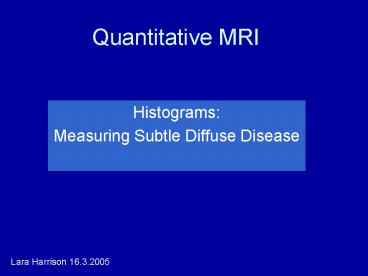Quantitative MRI PowerPoint PPT Presentation
1 / 24
Title: Quantitative MRI
1
Quantitative MRI
- Histograms
- Measuring Subtle Diffuse Disease
Lara Harrison 16.3.2005
2
Introduction
- The Histogram is a frequency distribution showing
the number of voxels with particular range of MR
parameter values - Histograms can be made for any MR parameter that
may be subtly altered by the precence of diffuse
disease
3
(No Transcript)
4
Introduction
- Histograms are increasingly being used to
characterize subtle diffuse disease changes in
normal appearing white matter tissue (NAWM) - MTR most common
- diffusion weighted (ADC)
- Focal lesion analysis after placing ROI
5
Histogram analysis
- no bias or pre-judgement about which parts of the
brain may be affected by disease - placing ROI is not needed
- no information on the location of abnormalities
- sensitivity best in diffuse lesions
6
Data Acquisition
- good practise in obtaining accurate values of MR
parameter - small voxel size -gt partial volume effect ?
- normal tissue ROI parameter values should be
checked for accuracy (comparison with published
data)
7
Data Acquisition
- Image de-spiking
- adding random noise to each floating point image
value before calculating parameter maps - makes images pseudo-continuous
- Parameter maps sufficient resolution
- scaling before storing
8
Image Segmentation
- identifying the outline of the tissue that is
being used to generate the histogram - good segmentation process
- reproducible
- accurate
- independent of human judgement as much as possible
9
Image Segmentation
- edge defining in clear way (anatomy, partial
volume voxels) - image data with different weighting from that
used to generate the parameter map
10
Generation of Absolute Histogram
- Bin width ?
- range of parameter (x-) values is divided up
reasonable number of bins - width ? -gt smoothing ?
- width ? -gt noise ?, large datasets
- often the bin width used is unity
- Range xmin - xmax
11
- Voxels Per Bin (VPB) histogram (hvpb)
- absolute histogram, shows voxel counts
- depend on bin width
- MPX histogram (hmpx)
- volume per x-unit (e.g.ml per pu or ml per ms)
- independent of bin width
- hmpx hvpb Vvox/?
- more easily compared between studies
12
Normalized Histogram
- partly normalized histograms correct for brain
volume, depend on bin width - hi 100 hivpb / (? hivpb)
- 100 himpx / (? himpx)
- fully normalized histograms correct for brain
volume, independ on bin width - hi 100 hivpb / (? ? hivpb)
- 100 himpx / (? ? himpx)
13
Histogram Smoothing
- High resolution histograms would probably benefit
from some smoothing - Median filtering
- range of filter ? -gt noise? -gt-gt peak height?
- if over-used step-like structure to the
histogram - very narrow bins might not respond well
14
Unimodal Histogram Features
- typical conventional features
- peak height
- peak location
- mean parameter value
- centile values (x25 etc)
15
(No Transcript)
16
Average magnetisation transfer ratio (MTR)
histograms of normal appearing brain tissue
(right) and of cervical spinal cord (left) from
healthy controls (solid lines) and patients with
secondary progressive MS (dotted lines). Compared
with healthy controls, patients with secondary
progressive MS have a reduction in histogram peak
height and a shift of the histogram to the left,
which indicates the presence of more pixels at
lower MTR. Filippi et al. 2003 The use of
quantitative magnetic-resonance-based techniques
to monitor the evolution of multiple sclerosis
17
Curve Fitting for Bimodal Histogram Features
- bimodal histograms cannot be well characterizated
by unimodal features - fitting the histogram to the sum of several
distributions described by analytic functions
(e.g. gaussians)
18
Curve Fitting for Bimodal Histogram Features
- each peak has an effective height, location and
width corresponding to the fitted function - analysis less depended on histogram structure at
the peak bin
19
Global Features
- MR parameters measured in disease have often
tested for clinical relevance - statistically significant differences between
diseases and disease subgroups - correlations with disease severity
- (MS Extended Disability Status Scale)
20
Global FeaturesPrinciple Component Analysis (PCA)
- PCA is widely used in modeling the statistics of
data sets - Dehmeshki et al. PCA optimal for correlation
with disease severity (MS EDSS), captures
within-class variance
21
(No Transcript)
22
Global Features Linear Discriminant Analysis
(LDA)
- LDA maximize the ratio of the between-group
variance to the within-group variance - Dehmeshki et al. LDA optimal for maximizing the
separation between groups of subjects (MS
sub-groups), captures between-class variance
23
What can go wrong?
- Data collection
- B1 field non-uniformity broaden histogram
- uncorrected errors in flip angle histogram shif
- Parameter maps
- rounding errors
- Segmentation
- strategy for dealing partial volume voxels
24
- Histogram Spikes
- common in high-resolution histograms
- mapping error spikes
- diffusion maps sometimes contain black pixels
- Bin-location Ambiquity
- labelling bin by its centre, not left edge
- Bin width too large
- peak location shift
- Interpolation of missing values guessing

